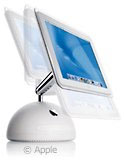According to a Cnet news story last week, some Mac fans are
"outraged" by Apple's announcement of a $100 across-the-board price
hike on the G4 iMac
last week at Macworld Expo Tokyo.
While nobody likes to see prices go up (at least from a consumer
perspective), people who waste their energy getting outraged by a price
increase on a commodity like a computer, especially when reasons for
the change are indisputable and beyond the vendor's control, ought to
get a life.
Apple explained that the reason for the price uptick is a
"significant increases in component costs for memory and LCD flat-panel
displays."
 Indeed, given increasing RAM prices plus a
worldwide shortage of the special type of glass used in flat panel LCD
display production, I have been wondering how long Apple could hold the
line on both iMac and iBook prices.
Indeed, given increasing RAM prices plus a
worldwide shortage of the special type of glass used in flat panel LCD
display production, I have been wondering how long Apple could hold the
line on both iMac and iBook prices.
If you've been following RAM prices over the past few months, then
you know there have been sharp increases. For example, the price of a
512 MB RAM module for my Pismo PowerBook bottomed out
last fall at about $85 but began to climb sharply toward the end of
2001. By the time I decided I'd better make my move in January, it cost
me $124.95 for a RAM upgrade from Other World Computing. I checked the
current price over the weekend, and it's now up to $139.95.
As for flat panel displays, the strong demand for glass laminate
from manufacturers of thin-film transistor liquid-crystal display
(TFT-LCD) panels combined with raw material procurement problems have
caused a panel shortage, and glass panel suppliers in Taiwan have
raised prices
DigiTimes.com
reports:
The price of large-size TFT LCDs, including that of
14.1-inch notebook panels, 15-inch panels for both LCD monitors and
notebooks, and 17-inch LCD monitor panels, have all increased in March.
However, many industry observers now warn that while the continuous
price hike is marvelous for panel producers, it certainly is not good
news for end-product producers and consumers and might eventually hurt
market demand.
15" LCD monitor panels like those used in the iMac have increased in
price from $210 in October, 2001, to $250-$260 in March 2002, a jump of
19-24%.
If Apple is to be faulted, it would have to be because the writing
was already on the wall last December when they would have been
finalizing prices for the iMac. However, if they already had a stock of
RAM and LCD displays purchased at the depressed prices of last year,
why not pass them on to the early adopter iMac purchasers for as long
as they could? And, of course, the low-ball prices helped in the with
the initial publicity impact of the new model.
Even at US$1,399-1,899, the G4 iMac is a whale of a deal. When it
was discontinued last spring, the basic 450 MHz G4 Cube with a DVD
drive, 64 MB of RAM, and a 20 GB hard drive was selling for $1,299.
When you added a 15 " Apple Studio Display, that bumped the total cost
up to $1,898, or just a buck less than the high-end 800 MHz iMac with a
15" LCD display; SuperDrive for playing and burning custom CDs and
DVDs; 256 MB RAM; a 40 GB hard drive; and Nvidia GeForce 2 MX graphics
with 32 MB of DDR memory.
Viewed in that context, the new iMac is still a stupendous deal even
at the new prices.

 Indeed, given increasing RAM prices plus a
worldwide shortage of the special type of glass used in flat panel LCD
display production, I have been wondering how long Apple could hold the
line on both iMac and iBook prices.
Indeed, given increasing RAM prices plus a
worldwide shortage of the special type of glass used in flat panel LCD
display production, I have been wondering how long Apple could hold the
line on both iMac and iBook prices.
